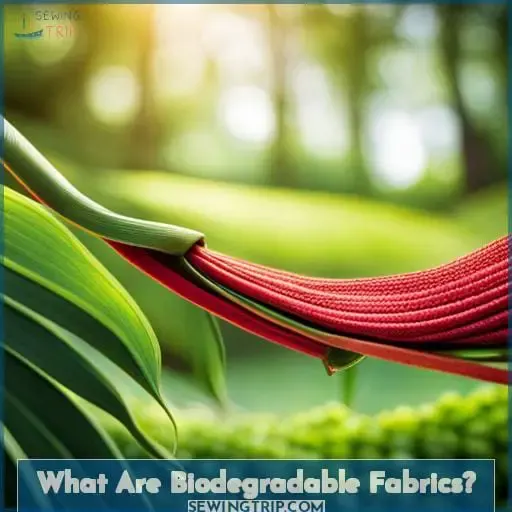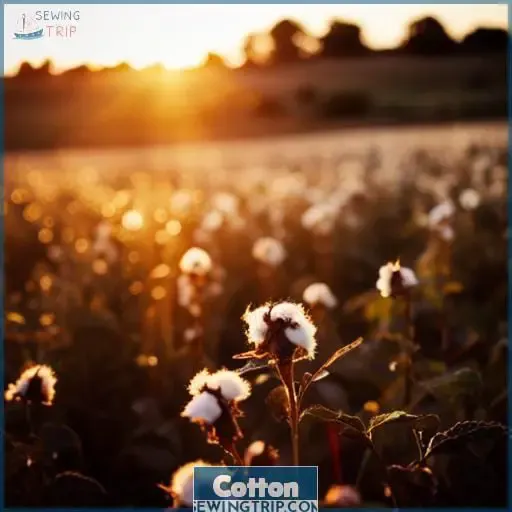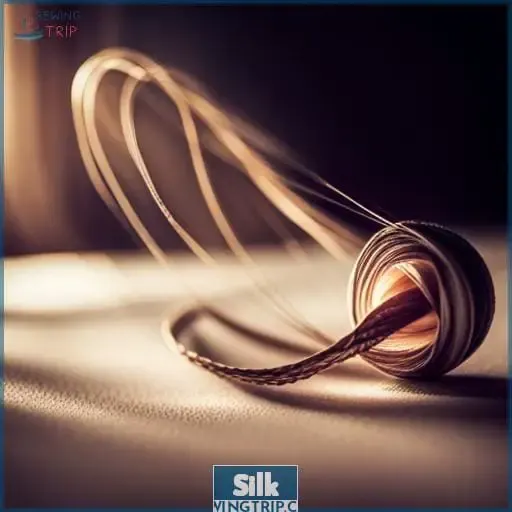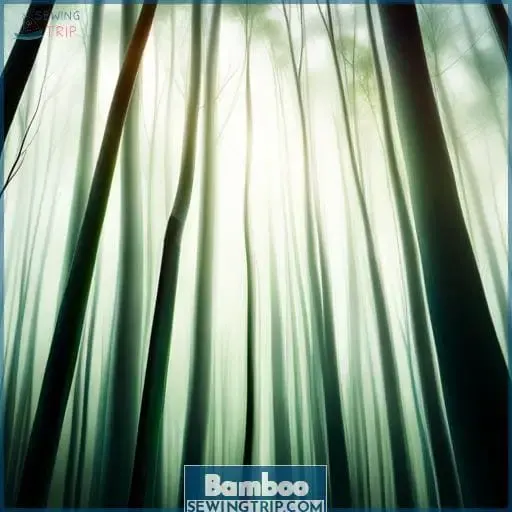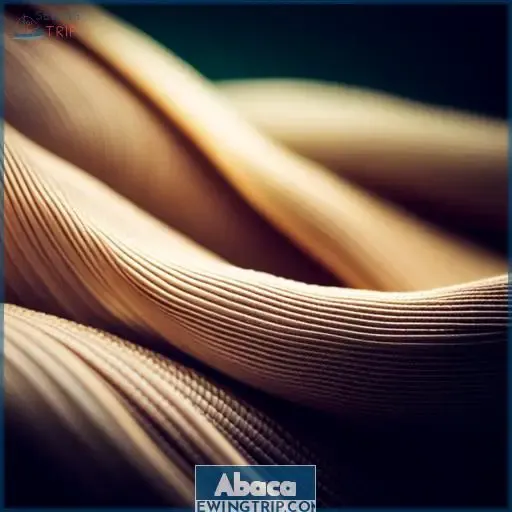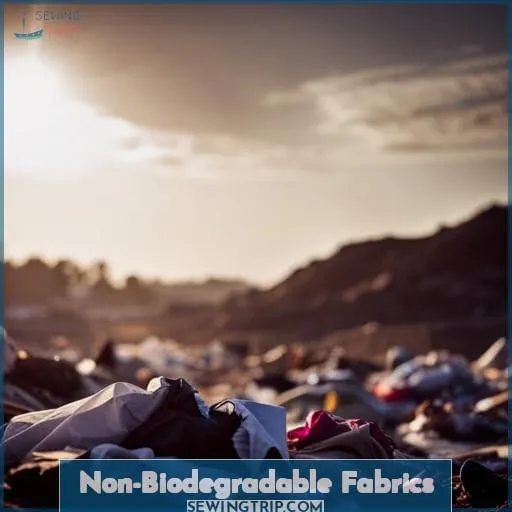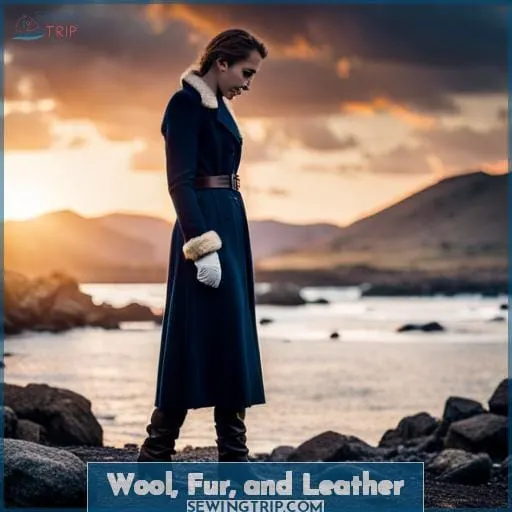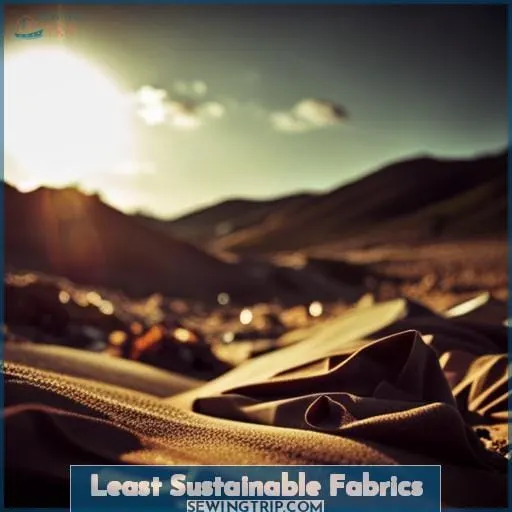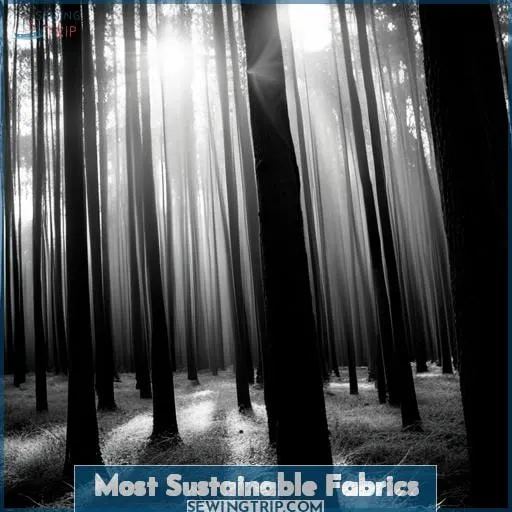This site is supported by our readers. We may earn a commission, at no cost to you, if you purchase through links.
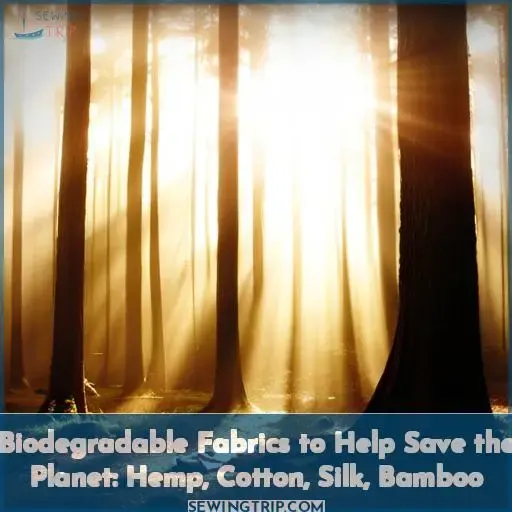 Methinks the garments enveloping our forms oft conceal unseemly origins.
Methinks the garments enveloping our forms oft conceal unseemly origins.
Yet, plant-spun threads may offer reprieve;
Hemp, cotton, silk, and bamboo grace Mother Earth with their demise.
As tides shift, choices cast ripples through humanity’s shared soil.
By donning organics, perhaps our skins shall pave fresh pathways to belonging,
Tilling insights into textiles once foreign.
Thus, thread by ethical thread, we may yet weave a new tapestry,
If we but align our actions with conscientious fabrics.
Table Of Contents
Key Takeaways
- Hemp and organic cotton enable closed-loop, regenerative sustainability through natural, pesticide-free cultivation practices.
- Bamboo thrives without fertilizers or pesticides due to its rapid growth cycle, making it a sustainable agricultural choice.
- Peace silk allows silkworms to live out full lifecycles and is an ethical, sustainable silk alternative compared to conventional practices.
- Look for undyed, certified organic cotton paired with other sustainable fabrics like hemp and Tencel lyocell.
What Are Biodegradable Fabrics?
As you’re shopping for clothes, you wonder what makes a fabric biodegradable.
Biodegradable fabrics can decompose through microbial breakdown, returning safely to nature without harming the environment. This natural decomposition process breaks down materials into their basic compounds.
Many plant-derived fabrics like hemp, organic cotton, and linen undergo biodegradation, but chemical dyes and treatments influence the process.
Ideally, biodegradable fabrics are created through fully sustainable practices, from raw material sourcing to end-of-life disposal. Compostable certification verifies a product will break down in commercial facilities.
Though silk biodegrades, its production raises ethical issues.
When sourced and manufactured responsibly, biodegradable textiles like hemp and organic cotton enable closed-loop, regenerative sustainability for the apparel industry.
Hemp
Most hemp fabrics are produced using natural and sustainable methods that cause no pollution, as farmers understand the importance of sustainable agriculture.
Hemp is manually cut and stripped from the plant, then woven into threads without the use of dangerous pesticides or insecticides.
As one of the most versatile and renewable materials on earth, hemp causes no pollution and returns nutrients back to the soil.
Its fibers become softer over time through wear, making old hemp fabrics easier to compost or biodegrade at end of life.
With consumers becoming more conscious of fashion’s impact, the popularity of hemp and other eco-fabrics continues to grow.
Brands like 8000Kicks use organic hemp to make durable yet breathable clothing and accessories that don’t pollute waterways or lead to deforestation.
When produced and manufactured sustainably, hemp brings only benefits.
Cotton
Organic cotton is free of pesticides, GMOs, and synthetic fertilizers, making it healthy and good for the environment.
As a sustainability expert focused on textiles, I advocate for organic cotton cultivation practices that utilize no chemicals and aim to protect soil health.
Seek out brands that use organic dyes and processes that minimize water consumption during production.
Though conventional cotton can technically be composted after use, dyes may contaminate soil.
For a truly circular production method, choose undyed, certified organic cotton, ideally paired with other sustainable fabrics like hemp, linen, or silk.
Together, conscious consumers and brands can transform supply chains toward ecological methods that nurture both people and planet.
Silk
You’re boiling silkworms alive when producing silk, which takes about 3,000 silkworms to make 1 pound.
Silk is a strong, antimicrobial fabric, yet its production raises ethical concerns.
Seek out alternatives like peace silk from the eri silkworm, harvested after metamorphosis so no lives are taken.
Support sustainable sericulture practices allowing silkworms to live out full lifecycles.
Used silk can be recycled into regenerated fibers, but biodegrading natural silk still emits methane.
Consider more sustainable vegan fabrics:
- Hemp needs few pesticides and fertilizers.
- Organic cotton prohibits harmful chemicals.
- Bamboo regrows rapidly without irrigation.
Or try innovative materials like Pinatex made of pineapple leaves.
Your clothing choices impact lives and land.
Bamboo
Since silk requires the death of silkworms, consider bamboo fabric as a more ethical and sustainable choice.
As one of the tallest grasses globally, bamboo thrives without fertilizers or pesticides. After harvesting, bamboo stalks get crushed and processed using natural enzymes to break down the woody parts into a soft, breathable fabric.
Bamboo fashion aligns with eco-friendly choices – the rapid growth of bamboo plants enables sustainable agriculture practices. Bamboo lyocell and other bamboo fabrics carry certifications like GOTS for natural, sustainable textiles.
By selecting bamboo over silk, you support sustainable innovations in fashion while avoiding harm to silkworms. Choose garments made from bamboo for an eco-friendly fabric that’s both durable and biodegradable.
Abaca
Although bamboo fabric is soft and breathable, abaca looks similar to burlap or hemp.
Abaca, also known as Musa textilis, is usually found in the Philippines and is often called Manila hemp.
It offers unique sustainability innovations.
This natural fiber has gained popularity in recent years due to its eco-friendly properties.
Compared to hemp, abaca fibers are finer and more lustrous while still maintaining strength and durability.
It requires minimal water usage during cultivation and doesn’t need chemical-intensive processing methods.
Abaca textiles have a wide range of applications including clothing, accessories, home furnishings, paper products, and even construction materials like ropes or twines for buildings.
The Sustainable Philippines initiative promotes the growth of abaca as an alternative sustainable material that supports local communities while reducing environmental impact.
Its versatility makes it a valuable addition to the biodegradable fabric family alongside other popular choices such as hemp, cotton, silk, and bamboo.
Non-Biodegradable Fabrics
Your clothes made from synthetics like polyester and nylon won’t decompose back into nature.
These petroleum-based fabrics shed microplastics when washed, polluting waterways and harming marine life.
Choosing more eco-friendly fabrics like hemp, organic cotton, linen, lyocell, and recycled polyester reduces environmental impact.
Support brands using circular manufacturing and sustainable agriculture.
Build a wardrobe minimizing water, pesticides, and waste.
Select durable, biodegradable fabrics to avoid landfill accumulation.
Together, our clothing choices shape industry standards – select consciously, buy less, make it last.
Thoughtful purchasing empowers both people and planet.
Wool, Fur, and Leather
You’ll need to thoughtfully consider wool, fur, and leather when seeking sustainable fabrics, as their biodegradability doesn’t guarantee responsible sourcing.
While wool and leather can be sourced responsibly, look for options like regenerated wool or leather to reduce environmental impact.
Better yet, choose animal-free alternatives – fabrics like hemp, organic cotton, linen, and lyocell have come a long way.
Silk, despite being biodegradable, can’t be considered sustainable due to the extremely unethical process of boiling silkworms alive.
Responsible brands focused on regenerative practices or animal-free lines are leading the way.
With so many great options available now, there’s no need to support cruel practices when dressing sustainably.
Least Sustainable Fabrics
We must confront the fabrics wreaking the most havoc:
- Polyester
- Acrylic
- Conventional cotton
- Rayon
- Nylon
These fabrics drive climate change, pollution, and unethical labor practices.
Choosing sustainable alternatives supports people and planet.
Polyester
Polyester is the least sustainable fabric:
- Non-biodegradable
- Derived from oil in an energy-intensive production process
- Releases microplastics harmful to marine life when washed
Contributes to microplastic pollution in waterways
Uses large amounts of energy in production
Not biodegradable or easily recycled
As a sustainability expert focused on environmental research, I encourage choosing more sustainable alternatives like hemp, organic cotton, recycled synthetics, bamboo, and silk.
These biodegradable options have less impact on marine life.
Acrylic
Acrylic is another fabric you’re better off avoiding, as its production utilizes toxic chemicals that can enter your body.
This synthetic material presents toxicity concerns and recycling challenges, negatively impacting the environment.
Consider more sustainable innovations like hemp, organic cotton, silk, or bamboo instead when shopping consciously.
Conventional Cotton
Conventional cotton’s high water consumption and use of harmful pesticides make it one of the least sustainable fabrics.
Without organic certification, cotton cultivation:
- Pollutes waterways with chemicals and dyes
- Uses pesticides that harm ecosystems
- Contributes to deforestation leading to habitat loss for endangered species
Choosing organic hemp, linen, or bamboo fabrics over conventional cotton supports more sustainable agriculture and manufacturing.
Rayon
You’ve learned that conventional cotton relies heavily on pesticides and insecticides that pollute waterways.
Rayon also negatively impacts the environment through intensive chemical processes that release dangerous chemicals and contribute to deforestation.
While rayon is made from plants, it requires:
- Toxic chemicals for production
- Intensive water usage
- Contribution to deforestation
Eco-conscious consumers should consider more sustainable alternatives like hemp, organic cotton, linen, or lyocell.
These closed-loop production methods significantly reduce environmental impact.
Nylon
Nylon, derived from crude oil, is non-biodegradable, releases microplastics, contributes to greenhouse gas emissions, and uses large amounts of water and energy.
Sustainable nylon alternatives like recycled polyester from plastic bottles or Tencel lyocell from wood pulp help reduce environmental impact.
Though innovative, these fabrics don’t fully eliminate problems like microplastic pollution from the fashion industry.
Seeking out circular fashion brands using eco-friendly production is key.
| Fabric | Impact | Solutions |
|---|---|---|
| Nylon | Non-biodegradable, microplastics | Recycled polyester, Tencel |
| Rayon | Deforestation | FSC certification |
| Cotton | Pesticides, water use | Organic cotton |
Most Sustainable Fabrics
When selecting your fabrics, prioritize:
- Organic cotton
- Linen
- Tencel lyocell
- Recycled polyester
These eco-friendly textiles minimize environmental impact compared to conventional options.
Support labels using certified sustainable materials or recycled content to reduce fashion’s footprint.
Organic Cotton
One can find over 220,000 organic cotton farms worldwide, with 60 in the U.S., growing cotton free of pesticides, GMOs, and synthetic fertilizers.
This organic option helps conserve soil health through sustainable agriculture practices like crop rotation that enhance water efficiency.
The chemical-free processing conserves energy while producing a soft, breathable fabric that supports your health and the environment’s.
Choosing organic cotton clothing assists the sustainable agriculture movement.
Linen
After considering organic cotton, you should also look into linen as one of the most sustainable fabrics.
Lightweight, crisp linen incorporates sustainably grown flax fibers.
The refreshing fabric requires minimal water, fertilizer, and pesticide usage.
As linen innovations align cleverly with eco-friendly trends, this breathable textile eases in blends with hemp, cotton, silk, or bamboo linen.
Lyocell
Your next sustainable fabric option is lyocell, a semi-synthetic made from eucalyptus wood pulp.
Lyocell is produced using closed-loop production methods that reuse over 99% of water and solvents.
As a fabric for the fashion-conscious consumer, lyocell offers unparalleled softness and drape.
Lyocell keeps ecosystems intact through responsible forestry and production practices.
Lyocell gives the industry hope for marrying style and sustainability.
Recycled Polyester
You can choose recycled polyester (rPET) fabric.
It’s made from plastic bottles, reducing raw materials needs and water use versus regular polyester.
But it still sheds microplastics.
Seek brands using recycled bottles in a closed-loop manufacturing process to make this eco-friendly fabric.
Pairing rPET with other green fabrics like hemp and organic cotton builds an ethical, sustainable wardrobe.
Frequently Asked Questions (FAQs)
How long does it take different biodegradable fabrics to break down?
Unfortunately, providing definitive timelines for how long different fabrics take to biodegrade is complicated.
Many factors influence biodegradation rates, including environmental conditions and chemicals used during production.
As sustainability experts, we aim to support fabrics that decompose naturally, cause no harm, and uphold ethical standards throughout their lifecycle.
Choosing consciously-sourced materials helps nurture healthier ecosystems.
Can you compost clothing made from biodegradable fabrics?
Yes, you can compost clothing made from truly biodegradable fabrics like:
- Organic cotton
- Hemp
- Linen
- Silk
Check labels to confirm materials used are 100% biodegradable.
Dyes or blended fabrics may interfere with composting effectiveness or soil health.
Trim any non-biodegradable parts first.
Do biodegradable fabrics decompose the same way in landfills as they would in a compost pile?
Unfortunately, most biodegradable fabrics don’t decompose properly in landfills.
With limited oxygen, moisture, and chemical runoff, biodegradation is extremely slow.
Composting offers better conditions for the natural breakdown of fabrics.
Consider donating unused clothing or recycling fibers into new textiles.
What tests or certifications can help identify truly biodegradable fabrics?
Look for third-party certifications like GOTS or OEKO-TEX to verify fabrics were produced sustainably.
Reputable ecolabels indicate biodegradable fabrics were made without harmful chemicals or wasted resources.
Trustworthy brands openly share production details too.
Are there any cons or downsides to choosing biodegradable fabrics over synthetic options?
Though biodegradable fabrics can help reduce waste, some cons exist.
They may encourage fast fashion due to perceptions of no environmental harm.
And biodegradable claims aren’t well regulated, so impacts aren’t guaranteed benign.
Carefully vet sources, and buy less, but better quality.
Conclusion
As threads of our shared future,
Fabrics envelop not just our forms but our fates.
By choosing conscientiously-sourced textiles like organics,
We may weave planetary tapestries that enrich rather than exploit.
Progress threads slowly,
Yet each mindful purchase aligns with ecological integrity.
So let biodegradable fabrics grace your skin,
That biosystems may thrive.
With care for textiles’ origins,
Perhaps we yet edge toward belonging:
Not just to clothes,
But the cosmic community that birthed us all.

